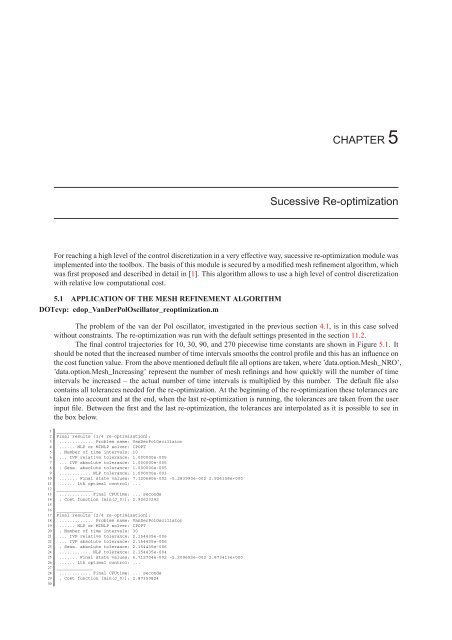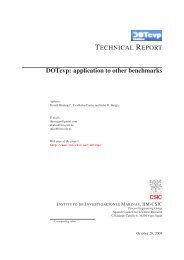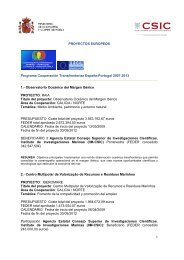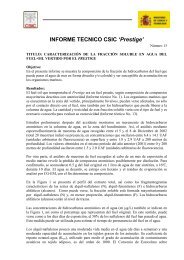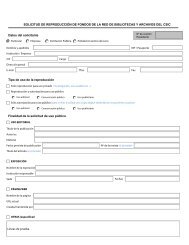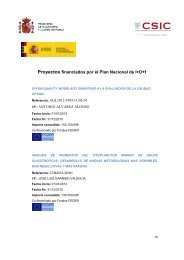DOTcvpSB: a Matlab Toolbox for Dynamic Optimization in Systems ...
DOTcvpSB: a Matlab Toolbox for Dynamic Optimization in Systems ...
DOTcvpSB: a Matlab Toolbox for Dynamic Optimization in Systems ...
You also want an ePaper? Increase the reach of your titles
YUMPU automatically turns print PDFs into web optimized ePapers that Google loves.
CHAPTER 5Sucessive Re-optimizationFor reach<strong>in</strong>g a high level of the control discretization <strong>in</strong> a very effective way, sucessive re-optimization module wasimplemented <strong>in</strong>to the toolbox. The basis of this module is secured by a modified mesh ref<strong>in</strong>ement algorithm, whichwas first proposed and described <strong>in</strong> detail <strong>in</strong> [1]. This algorithm allows to use a high level of control discretizationwith relative low computational cost.5.1 APPLICATION OF THE MESH REFINEMENT ALGORITHMDOTcvp: cdop_VanDerPolOscillator_reoptimization.mThe problem of the van der Pol oscillator, <strong>in</strong>vestigated <strong>in</strong> the previous section 4.1, is <strong>in</strong> this case solvedwithout constra<strong>in</strong>ts. The re-optimization was run with the default sett<strong>in</strong>gs presented <strong>in</strong> the section 11.2.The f<strong>in</strong>al control trajectories <strong>for</strong> 10, 30, 90, and 270 piecewise time constants are shown <strong>in</strong> Figure 5.1. Itshould be noted that the <strong>in</strong>creased number of time <strong>in</strong>tervals smooths the control profile and this has an <strong>in</strong>fluence onthe cost function value. From the above mentioned default file all options are taken, where ’data.option.Mesh_NRO’,’data.option.Mesh_Increas<strong>in</strong>g’ represent the number of mesh ref<strong>in</strong><strong>in</strong>gs and how quickly will the number of time<strong>in</strong>tervals be <strong>in</strong>creased – the actual number of time <strong>in</strong>tervals is multiplied by this number. The default file alsoconta<strong>in</strong>s all tolerances needed <strong>for</strong> the re-optimization. At the beg<strong>in</strong>n<strong>in</strong>g of the re-optimization these tolerances aretaken <strong>in</strong>to account and at the end, when the last re-optimization is runn<strong>in</strong>g, the tolerances are taken from the user<strong>in</strong>put file. Between the first and the last re-optimization, the tolerances are <strong>in</strong>terpolated as it is possible to see <strong>in</strong>the box below.1 ______________2 F<strong>in</strong>al results [1/4 re-optimization]:3 ............. Problem name: VanDerPolOscillator4 ...... NLP or MINLP solver: IPOPT5 . Number of time <strong>in</strong>tervals: 106 ... IVP relative tolerance: 1.000000e-0057 ... IVP absolute tolerance: 1.000000e-0058 . Sens. absolute tolerance: 1.000000e-0059 ............ NLP tolerance: 1.000000e-00310 ....... F<strong>in</strong>al state values: 7.120680e-002 -5.283990e-002 2.926158e+00011 ...... 1th optimal control: ...12 ______________13 ............ F<strong>in</strong>al CPUtime: ... seconds14 . Cost function [m<strong>in</strong>(J_0)]: 2.926232921516 ______________17 F<strong>in</strong>al results [2/4 re-optimization]:18 ............. Problem name: VanDerPolOscillator19 ...... NLP or MINLP solver: IPOPT20 . Number of time <strong>in</strong>tervals: 3021 ... IVP relative tolerance: 2.154435e-00622 ... IVP absolute tolerance: 2.154435e-00623 . Sens. absolute tolerance: 2.154435e-00624 ............ NLP tolerance: 2.154435e-00425 ....... F<strong>in</strong>al state values: 6.712704e-002 -5.209653e-002 2.873413e+00026 ...... 1th optimal control: ...27 ______________28 ............ F<strong>in</strong>al CPUtime: ... seconds29 . Cost function [m<strong>in</strong>(J_0)]: 2.8735082430


